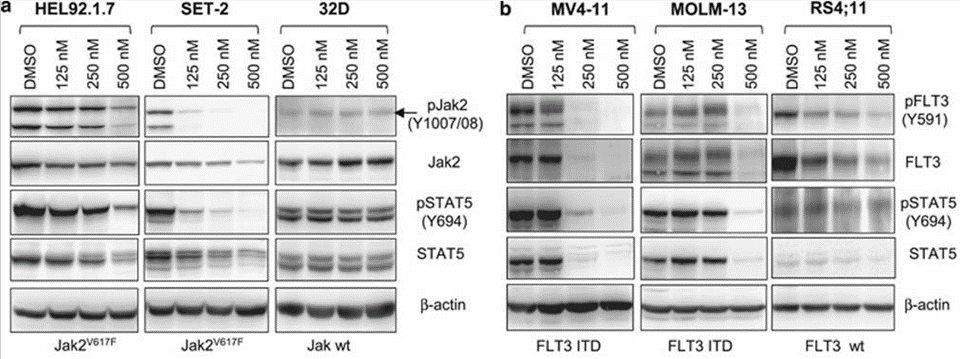| Description | Pracinostat (SB939) is a potent pan-HDAC inhibitor with IC50 of 40-140 nM with exception for HDAC6. It has no activity against the class III isoenzyme SIRT I. Pracinostat (SB939) induces apoptosis in tumor cells. Phase 2. |
|---|
| Features | A new histone deacetylase inhibitor based on hydroxamic acid, with improved physicochemical, pharmaceutical, and pharmacokinetic properties. |
|---|
| Targets | |
|---|
| In vitro |
| In vitro | SB939 has a 100-fold greater selectivity for HDACs than for Zn-binding non-HDAC enzymes, receptors, and ion channels. SB939 is a potent inhibitor of HDAC class I isoenzymes, HDAC1, HDAC2, HDAC3 and HDAC8 with the IC50 values ranging from 43 nM to 140 nM. SB939 inhibits HDAC class II isoenzymes , HDAC4, HDAC5, HDAC7, HDAC9 and HDAC10 significantly with the IC50 values ranging from 40 nM to 137 nM, with the exception of HDAC6 which shows IC50 of 1008 nM. It markedly inhibits HDAC11 of the HDAC class IV enzymes with IC50 of 93 nM, but shows no inhibitory activity against SIRT 1 of the class III HDACs. SB939 shows significant antiproliferative activity against a wide variety of tumor cell lines, especially Leukemia cells and cutaneous T-cell Lymphoma cells with IC50 values ranging from 50 nM (H9 cells) to 170 nM (HEL92.1.7 cells). [1] |
|---|
| Kinase Assay | HDAC enzyme assay |
|---|
| All recombinant HDAC enzymes, with the exception of SIRT1, are cloned and expressed in S*BIO. The reaction mix containing 2.5 or 5 μL of the HDAC isoenzyme, assay buffer (25 mM Tris-HCl, pH 7.5; 137 mM NaCl; 2.7 mM KCl, 1 mM MgCl2 and 1 mg/mL BSA), different concentrations of SB939, and the fluorogenic deacetylase substrate Flour de LysTM in a total reaction volume of 33 μL is incubated at room temperature for 2 hours. 16 μL of Flour de LysTM developer is added and incubated for an additional 10 minutes. The emitted light is measured at 460 nm in a microplate reader. IC50 values are generated using the XLfit software. |
| Cell Research | Cell lines | HCT116, A2780, ACHN, MCF7, HL-60, et al. |
|---|
| Concentrations | Dissolved in DMSO (stock concentration, 10 mM), final concentrations 1.5 nM to 100 μM |
| Incubation Time | 96 hours |
| Method | Cells are seeded in 96-well plates in the log growth phase at a predetermined optimal density, and rested for 24 hours (adherent cells) or 2 hours (suspension cells), respectively. They are exposed to different concentrations of SB939 for 96 hours. Cell proliferation assays are done using either the CyQUANT cell proliferation assay kit for adherent cells or the CellTiter96 Aqueous One solution cell proliferation kit for suspension cells. |
| Experimental Result Images | Methods | Biomarkers | Images | PMID |
|---|
| Western blot | p-JAK2 / JAK2 / p-STAT5 / STAT5 / p-FLT3 / FLT3 |  | 22829971 |
| In Vivo |
| In vivo | Administration of SB939 (25 mg/kg to 100 mg/kg) displays a dose-dependent antitumor efficacy in a xenograft mice model of human colorectal cancer (HCT-116). This is approximately twice as efficacious as SAHA: SB939 causing a tumor growth inhibition of 94% versus 48% by SAHA with both at the maximum tolerated dose. Oral administration of SB939 at a dose of 50 mg/kg or 75 mg/kg in the APCmin genetic mice model of early-stage colon cancer markedly reduces the number of tumors , decreases cumulative hemocult scores and increases hematocrit values more effectively. [1] |
|---|
| Animal Research | Animal Models | BALB/c nude mice bearing HCT-116 human colon cancer xenografts, Male and APCmin mice |
|---|
| Dosages | 25, 50, 75, or 100 mg/kg |
| Administration | Oral gavage once daily |
https://www.labmartgh.com/shop/product/pracinostat-sb939-99-99-27229
-
Pack Size:
10mg
50mg
1g
5mg
10 mM x 1 mL in DMSO
200mg
Resources file not found.





 0
0
